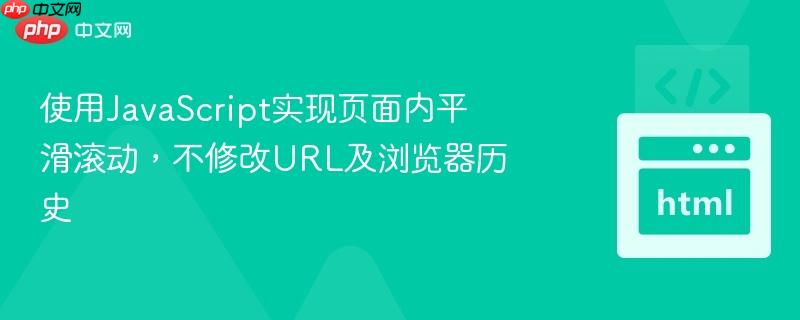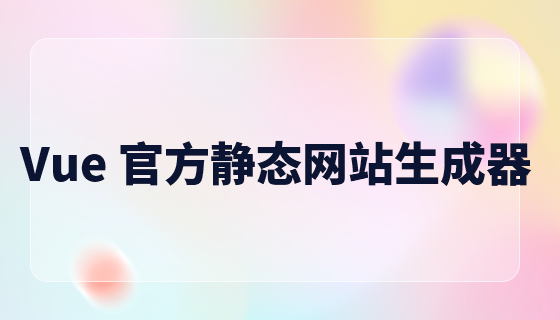
本文旨在解决传统锚点链接(`#id`)在页面内跳转时修改URL和浏览器历史记录的问题。我们将详细介绍如何利用JavaScript的`scrollIntoView()`方法,实现页面内容的平滑滚动,同时保持URL不变,从而优化用户体验并避免不必要的历史记录污染。通过示例代码和注意事项,帮助开发者构建更流畅的单页应用或复杂页面导航。
在现代网页设计中,用户体验是至关重要的一个环节。传统的HTML锚点链接(如<a href="#sectionId"></a>)能够实现页面内部的快速跳转,但这种方式会改变浏览器的URL地址(在URL末尾添加#sectionId),并且会向浏览器的历史记录中添加一个新条目。这在某些场景下可能会导致不便,例如用户点击“返回”按钮时,并非返回到上一个外部页面,而是返回到同一页面内的上一个锚点位置,这可能与用户的预期不符。
为了避免上述问题,我们可以利用JavaScript提供的scrollIntoView()方法。这个方法允许我们以编程方式将指定元素滚动到可见区域,而无需修改URL或污染浏览器历史记录。
Element.scrollIntoView()是一个DOM元素方法,它会滚动元素的父容器,直到该元素在用户可见区域内。它接受一个可选的scrollIntoViewOptions对象作为参数,允许我们控制滚动的行为。
立即学习“Java免费学习笔记(深入)”;
以下是一个简单的示例,演示如何通过点击按钮将页面滚动到指定内容区域,而URL保持不变:
<!DOCTYPE html>
<html lang="zh-CN">
<head>
<meta charset="UTF-8">
<meta name="viewport" content="width=device-width, initial-scale=1.0">
<title>页面内滚动不修改URL</title>
<style>
body {
font-family: Arial, sans-serif;
margin: 0;
padding: 20px;
height: 2000px; /* 制造足够长的页面以便滚动 */
background-color: #f4f4f4;
}
.header {
position: fixed;
top: 0;
left: 0;
width: 100%;
background-color: #333;
color: white;
padding: 10px 20px;
box-sizing: border-box;
z-index: 1000;
}
.content-section {
margin-top: 80px; /* 留出头部空间 */
padding: 20px;
background-color: white;
border-radius: 8px;
box-shadow: 0 2px 4px rgba(0,0,0,0.1);
margin-bottom: 20px;
}
#targetSection {
background-color: #e0f7fa;
border: 1px solid #00bcd4;
min-height: 400px; /* 确保目标区域足够大 */
display: flex;
align-items: center;
justify-content: center;
font-size: 2em;
color: #00796b;
}
.scroll-button {
padding: 10px 15px;
background-color: #007bff;
color: white;
border: none;
border-radius: 5px;
cursor: pointer;
font-size: 1em;
margin-right: 10px;
}
.scroll-button:hover {
background-color: #0056b3;
}
</style>
</head>
<body>
<div class="header">
<h1>页面导航示例</h1>
<button class="scroll-button" onclick="scrollToElement('targetSection')">跳转到目标内容</button>
<button class="scroll-button" onclick="scrollToElement('anotherSection')">跳转到另一段内容</button>
</div>
<div class="content-section" style="height: 600px;">
<h2>第一部分内容</h2>
<p>这里是页面的第一部分,包含了一些介绍性文字。请向下滚动或点击导航按钮查看更多内容。</p>
<p>Lorem ipsum dolor sit amet, consectetur adipiscing elit. Sed do eiusmod tempor incididunt ut labore et dolore magna aliqua. Ut enim ad minim veniam, quis nostrud exercitation ullamco laboris nisi ut aliquip ex ea commodo consequat.</p>
</div>
<div class="content-section" id="anotherSection" style="height: 500px;">
<h2>第二部分内容</h2>
<p>这是页面的第二部分,我们可以在这里放置一些详细的信息或功能模块。通过点击顶部按钮,可以直接跳转到这里。</p>
<p>Duis aute irure dolor in reprehenderit in voluptate velit esse cillum dolore eu fugiat nulla pariatur. Excepteur sint occaecat cupidatat non proident, sunt in culpa qui officia deserunt mollit anim id est laborum.</p>
</div>
<div class="content-section" id="targetSection">
这是一个重要的目标内容区域!
</div>
<div class="content-section" style="height: 700px;">
<h2>第三部分内容</h2>
<p>这是页面的第三部分,位于目标内容之后。您可以继续向下浏览。</p>
<p>Curabitur pretium tincidunt lacus. Nulla facilisi. Proin volutpat, sem id eleifend tristique, magna enim eleifend urna, vel sollicitudin est velit a libero. Sed eu ante vitae nisl aliquam semper.</p>
</div>
<script>
function scrollToElement(elementId) {
// 根据ID获取目标元素
const element = document.getElementById(elementId);
// 检查元素是否存在
if (element) {
// 调用 scrollIntoView() 方法
element.scrollIntoView({
behavior: 'smooth', // 平滑滚动效果
block: 'start' // 将元素的顶部与视口顶部对齐
});
} else {
console.warn(`元素ID为 "${elementId}" 的目标未找到。`);
}
}
</script>
</body>
</html>HTML 结构:
JavaScript 函数 scrollToElement(elementId):
通过这种方式,当用户点击按钮时,页面会平滑地滚动到id为targetSection的元素,而浏览器的URL地址栏不会有任何变化,也不会产生新的历史记录条目。
scrollIntoView()方法为前端开发者提供了一种优雅的解决方案,用于实现页面内内容的平滑滚动,同时避免了传统锚点链接修改URL和浏览器历史记录的问题。通过合理利用其参数,我们可以定制滚动的行为,从而在不牺牲用户体验的前提下,保持URL的整洁和浏览器历史记录的纯净。在构建需要精细控制页面导航的网站时,掌握这一技巧将非常有益。
以上就是使用JavaScript实现页面内平滑滚动,不修改URL及浏览器历史的详细内容,更多请关注php中文网其它相关文章!

每个人都需要一台速度更快、更稳定的 PC。随着时间的推移,垃圾文件、旧注册表数据和不必要的后台进程会占用资源并降低性能。幸运的是,许多工具可以让 Windows 保持平稳运行。




Copyright 2014-2025 https://www.php.cn/ All Rights Reserved | php.cn | 湘ICP备2023035733号